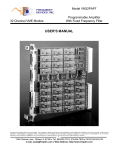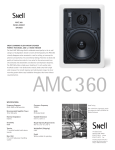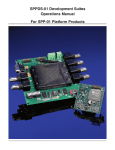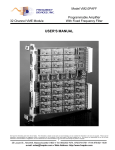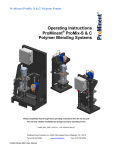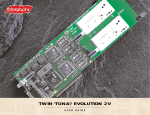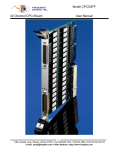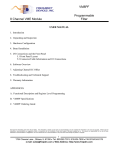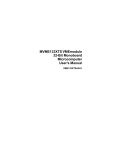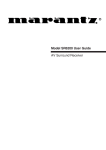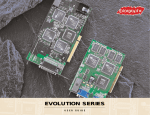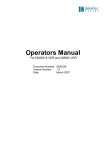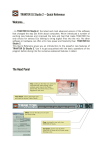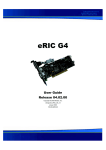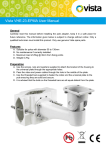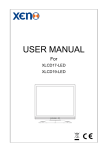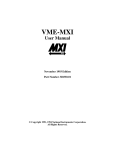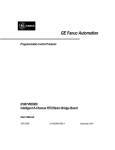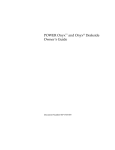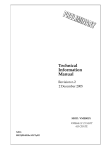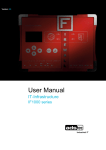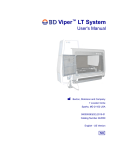Download User Manual PDF File
Transcript
Model VM8DAC Low Noise Digital to Analog Converter 8 Channel VME Module USER’S MANUAL We hope the information given here will be helpful. The information is based on data and our best knowledge, and we consider the information to be true and accurate. Please read all statements, recommendations or suggestions herein in conjunction with our conditions of sale which apply to all goods supplied by us. We assume no responsibility for the use of these statements, recommendations or suggestions, nor do we intend them as a recommendation for any use which would infringe any patent or copyright. 1 25 Locust St., Haverhill, Massachusetts 01830 • Tel: 800/252-7074, 978/374-0761 • FAX:978/521-1839 e-mail: [email protected] • Web Address: http://www.freqdev.com Model VM8DAC 8 Channel VME Module Contents, Figures and Tables Low Noise Digital to Analog Converter Contents 1. Introduction ...............................................................................................................................................4 Features/Benefits ..............................................................................................................................4 2. Specifications............................................................................................................................................5 3. Description................................................................................................................................................6 VMEBus Interface .............................................................................................................................6 Master Clock Interface and Timebase Control Logic ........................................................................6 DAC/Amplifiers and Output Connections ..........................................................................................7 External Power Supply Interface.......................................................................................................7 4. Hardware Preparation...............................................................................................................................8 Unpacking and Inspection.................................................................................................................8 Hardware Configuration ....................................................................................................................9 VMEbus Base Address .....................................................................................................................9 Grounding Configuration .................................................................................................................11 Board Installation ............................................................................................................................12 I/O Connections and the Front Panel..............................................................................................12 Clock Input Connector.....................................................................................................................14 External Power Supply Connector ..................................................................................................14 Analog Output (DAC) Connector.....................................................................................................16 5. Programming ..........................................................................................................................................17 Memory Map and Register/Bit Descriptions....................................................................................17 Programming the Timebase............................................................................................................19 DAC Data Write Timing and Constraints.........................................................................................19 Synchronizing with the Sample Clock .............................................................................................19 6. Troubleshooting and Technical Support .................................................................................................21 7. Warranty Information ..............................................................................................................................22 Limitation of Liability........................................................................................................................22 8. Ordering Guide .......................................................................................................................................23 Figures Figure 3-1: A VM8DAC Channel...................................................................................................................6 Figure 4-1: VM8DAC Base Address Configuration Jumpers. .......................................................................9 Figure 4-2: VM8DAC GND Jumper Setup. .................................................................................................10 Figure 4-3: VM8DAC Front Panel ...............................................................................................................12 Figure 4-4: VM8DAC External Power Supply Connector............................................................................14 Figure 5-1: VM8DAC VMEbus Memory Map. .............................................................................................17 Figure 5-2: VM8DAC Board Data Transfer Timing. ....................................................................................19 Tables Table 4-1: External Power Supply Connections. ........................................................................................13 Table 4-2: Analog Output Connections.......................................................................................................15 2 25 Locust St., Haverhill, Massachusetts 01830 • Tel: 800/252-7074, 978/374-0761 • FAX:978/521-1839 e-mail: [email protected] • Web Address: http://www.freqdev.com Model VM8DAC 8 Channel VME Module Introduction Low Noise Digital to Analog Converter 1. Introduction The VM8DAC VMEbus digital to analog converter (DAC) board from Frequency Devices Inc. offers eight channels of precision low-distortion/low-noise digital to analog converters that operate with a sample clock frequency generated from a software programmable differential input external clock master timebase divider. The boards are available in a single width B-size (6U) VME form factor and fully conform to VMEbus Revision C.1 as an A32/D32 Data Transfer Bus Slave. VM8DAC’s provide high resolution (24-bit) and low resolution (16-bit) data access to on-board DAC’s. The boards interpret the received parallel data from the VMEbus as binary 2’s complement. This data is serialized and transferred to any selected DAC channel at a fixed master timebase where it is converted to analog signals at a software programmable sampling rate. The DAC channels may be configured to 16,384, 8,192, 4,096, or 2,048 samples per second. Features/Benefits • Eight discrete channels with programmable sampling that provide a 24- bit DAC stage for each channel offers the user versatile and convenient digital to analog conversion. • Outputs synchronized to the front panel external clock allow for multi-card synchronicity. • Designed for Real Time Operating Systems (RTOS) to provide minimal pipeline delay (less than 5 microseconds). i.e. Linux or Vx Works. • Interrupt free operation provides glitch energy of <5nV-sec and extremely low noise density (<100nV/ Hz ). • VME backplane is galvanically isolated from the analog section to reduce system integration problems. 3 25 Locust St., Haverhill, Massachusetts 01830 • Tel: 800/252-7074, 978/374-0761 • FAX:978/521-1839 e-mail: [email protected] • Web Address: http://www.freqdev.com Model VM8DAC 8 Channel VME Module Specifications Low Noise Digital to Analog Converter 2. Specifications (@ 25oC and Rated Power Input) Module Size/Dimensions 1. Standard 6U VME, single slot module 2. Weight Connectors 3. Input clock connector 4. Analog output connector 5. Matching output connector External Clock Input 6. Configuration 7. Isolation 8. Frequency Analog output 9. Number of channels per board 10. Analog output configuration 11. Minimum output load 12. Maximum output voltage 13. Output amplifier 3 dB bandwidth 14. Output impedance 15. Anti-image filter 16. Inter-channel crosstalk DAC specifications 17. Number of bits 18. Binary number format 19. Sampling rate 20. Bipolar zero error 21. Bipolar zero error drift 22. Glitch energy 23. Output-referred noise 24. Amplitude match and accuracy 25. Harmonic spikes 26. Output settling time to 1% Power requirements 27. From the + 5V VME backplane supply 28. From the +/- 12V VME backplane supply VME interface 29. Interface configuration 30. Address modifier lines decoding 31. Data word size 32. Bus cycle compatibility 33. Addressing modes Environmental 34. Operating Temperature range 35. Storage Temperature range 36. Humidity 9.17 X 6.3 inches (233 X 160 mm) ~ 1 lb., 0.45 kg Lemo EPG.OB.302.HLN Male DB25 Female DB25 Differential, TTL compatible Transformer isolated 222 Hz (4.194305 MHz) 8 Differential 500 ohm ± 10V into 10 kOhm >50KHz 50 ohms per leg None < -90dB (frequencies less than 50KHz) 24 bits Binary 2’s complement 16,384, 8,192, 4,096, 2,048 samples per second ±2% F.S. maximum ± 5 ppm of FS/ °C < 5nV-sec <100nV/vHz (40 Hz to 8192 Hz with FS 1000 Hz sine wave) ± 0.1 dB <-100 dB (referred to a full scale output signal ) < 5 microseconds (From output clock edge) 1.0 A Max. 1.0 A A32/D32 VME Data Transfer Bus (DTB) Slave Full decode (0x09, 0x0A, 0x0D, and 0x0E valid) Long word (Quad Byte) and aligned word (Double Byte) AO, RMW, bus cycles address pipelining A32 (Extended) addressing only 0oC to +70oC -25oC to +85oC 0-95% non-condensing 4 25 Locust St., Haverhill, Massachusetts 01830 • Tel: 800/252-7074, 978/374-0761 • FAX:978/521-1839 e-mail: [email protected] • Web Address: http://www.freqdev.com Model VM8DAC 8 Channel VME Module Hardware Preparation Low Noise Digital to Analog Converter 3. Description The VM8DAC is a single width B-size (6U) VME module that consists of a motherboard offering eigth differential output DAC channels. The motherboard is divided into a VME-grounded digital section and a galvanically isolated analog section. The “digital section” includes the VMEbus-to-DAC interface, the master clock interface, and the timebase control logic. The “analog section” contains the opto-isolated high precision DAC/amplifiers, the external power supply interface, and output connections. VMEBus interface The VM8DAC appears on the VMEbus as a Revision C.1 compliant A32/D32, VME Data Transfer Bus (DTB) Slave with full decoding of address modifier lines. The board supports long word (Quad Byte) and aligned word (Double Byte) transfers and is compatible with Address Only (AO) and Read-Modify-Write (RMW) bus cycles as well as with address pipelining. An on-board field programmable gate array (FPGA) is hard-coded to allow the board to respond to address modifier codes 0x09, 0x0A, 0x0D, and 0x0E. The board assumes A32 (Extended) addressing and does not respond to A24 (Standard) or A16 (Short) bus address cycles. The VM8DAC board does not support Block Transfers (BLT), unaligned transfers, byte transfers, the VME Serial Bus (VSB), or any features of VME64 or later enhancements. The board does not provide bus mastering (DMA) capability or interrupt capability, however it is fully compatible with systems that make extensive use of DMA and interrupts. The VMEbus backplane offers a software programmable interface to set the actual sample clock frequency of each DAC channel. Through the interface any user can set a programmable timebase divider, readback a control word to determine when the board is ready for more data, and send digital signal data. The board uses an indexed channel addressing scheme to serialize VME digital signal data and transfer it to the selected DAC/amplifier channel. Figure 3-1 is a simplified block diagram of the VM8DAC showing one DAC/amplifier channel and all of the common functions. Master Clock Interface and Timebase Control Logic The VM8DAC provides a Differential/TTL-compatible/Transformer-isolated external clock input. The board’s timebase is derived from an 222 Hertz (4.19304 MHz, nominal) external clock that is brought onto the board over the front panel. On board logic divides this timebase clock by four to provide a board level master timebase of 220 Hz (1.048576 MHz, nominal). The sample clock pulse width is fixed at one cycle of this on board master timebase (approximately 954 nanoseconds, nominal). In addition, a software programmable divider, further divides the master timebase to provide the actual sample clock frequency. Refer to the external time base select coding in Figure 5-1 in the programming section. 5 25 Locust St., Haverhill, Massachusetts 01830 • Tel: 800/252-7074, 978/374-0761 • FAX:978/521-1839 e-mail: [email protected] • Web Address: http://www.freqdev.com Model VM8DAC 8 Channel VME Module Hardware Preparation Low Noise Digital to Analog Converter DAC/Amplifiers and Output Connections The DAC/amplifiers are located on the analog section of the VM8DAC. Each channel contains two pairs of DAC’s and one pair of I/V converter/amplifiers. DAC's I/V's Data WCLK BCLK Invert D W B Out I D W B Ch x OUT PLUS Out I D W B Out I D W B Ch x OUT MIN Out I Figure 3-1: A VM8DAC Channel. X represents the channel number of 1 up to 8. The VME-DAC interface generates the inputs to the DAC’s. The inputs to the DAC’s are a bit clock, a word clock , and the serial data. The serial data is connected in a non-inverting fashion two one pair of DAC’s and in an inverting fashion to the other DAC pair. This converts the output to a differential one. The output of each DAC’s pair is connected to an I/V converter amplifier which provides low output impedance. The output of each I/V converter pair is sent to he output connector as the specific channel’s low impedance differential signal. External Power Supply Interface An external power supply interface provides the option of using external power supplies connected through a DB15 female connector located on the front panel. Using external power supplies results in lower common mode noise as all power is derived from external sources and not from the VME backpanel. 6 25 Locust St., Haverhill, Massachusetts 01830 • Tel: 800/252-7074, 978/374-0761 • FAX:978/521-1839 e-mail: [email protected] • Web Address: http://www.freqdev.com Model VM8DAC 8 Channel VME Module Hardware Preparation Low Noise Digital to Analog Converter 4. Hardware Preparation Unpacking and Inspection Before unpacking the VM8DAC shipping container, carefully inspect the exterior of the package for evidence of damage. After noting areas of possible shipping damage, open and unpack the shipping container, being careful to preserve the container and packing materials in case they are needed later. CAUTION: The VM8DAC Board is sensitive to STATIC ELECTRICITY. Use proper GROUNDING TECHNIQUES when handling the board. Carefully remove the VM8DAC board from its anti-static bag and visually inspect for evidence of damage. If the board appears to be damaged in any way, notify the shipping carrier. 7 25 Locust St., Haverhill, Massachusetts 01830 • Tel: 800/252-7074, 978/374-0761 • FAX:978/521-1839 e-mail: [email protected] • Web Address: http://www.freqdev.com Model VM8DAC 8 Channel VME Module Hardware Preparation Low Noise Digital to Analog Converter Hardware Configuration Once the VM8DAC VMEbus board has been removed from its anti-static bag and carefully inspected for damage, you are ready to configure the board for your particular system. CAUTION: The VM8DAC Board is sensitive to STATIC ELECTRICITY. Use proper GROUNDING TECHNIQUES when handling the board. VMEbus Base Address The selection of DAC channels and the timebase programming is done through VME memory space using a Base Address that can be set throughout all of A32 space. A VM8DAC board occupies a 256-byte block in A32 address space and may be configured on any 256-byte boundary. The user will need to set a Base Address that is appropiate for the VME system in which the VM8DAC will be installed. The factory set Base Address is 2000(hex). Before attempting to use the board, the user should set/verify the base address using the address DIP switch blocks SW1, SW2, and SW3 on the board. To reconfigure the VM8DAC Base Address, lay the board flat as shown in Figure 4-1. See the three DIP switches that make the 24 position switch block shown in Figure 4-1. This switch block is used to set the board's base address in A32 address space. SW1 set address lines A24 through A32, SW2 set address lines A17 up to A23, and SW3 set lines A8 up to A16. A bit switch moved to the right sets a logic '1' while a bit switch moved to the left sets a logic '0'. For example, to set the VM8DAC Base Adresss to 800(hex), the bit switch which corresponds to A11 is moved to the right and all the other switches to the left. 8 25 Locust St., Haverhill, Massachusetts 01830 • Tel: 800/252-7074, 978/374-0761 • FAX:978/521-1839 e-mail: [email protected] • Web Address: http://www.freqdev.com Model VM8DAC 8 Channel VME Module Hardware Preparation Low Noise Digital to Analog Converter Figure 4-1: VM8DAC Base Address Configuration Jumpers. An installed jumper sets a logic '1' while a missing jumper sets a logic '0'. 9 25 Locust St., Haverhill, Massachusetts 01830 • Tel: 800/252-7074, 978/374-0761 • FAX:978/521-1839 e-mail: [email protected] • Web Address: http://www.freqdev.com Model VM8DAC 8 Channel VME Module Hardware Preparation Low Noise Digital to Analog Converter Grounding Configuration The DAC/amplifier “analog” signal ground reference point can be connected to chassis ground or to the VMEbus back plane ground. If neither connection is made, the analog portion of the board is galvanically floating so that its ground (AGND) is isolated from VME system ground. Floating means signal ground is isolated from the chassis and back plane and is referenced to external signal ground through the I/O cables. This allows the user to connect the analog common to other commons without creating low frequency ground loops. A set of jumpers is provided to allow the analog common to be connected to either VME system ground or chassis ground through the board front panel. See Figure 4-2 for ground jumper setup information. To change the signal ground reference point, locate the ground reference jumper J2 and jumper the ANALOG GND post to the appropriate position. Note that to select a FLOATING ground, no jumper connection is made. NC CHASSIS GND ANALOG GND J2 U48 - P.S. VMEBP GND Figure 4-2: VM8DAC GND Jumper Setup. Jumper the ANALOG GND post to either CHASSIS GND or VMEBP GND. After the board's base address and grounding has been configured, the board is ready for installation in a VME system. 10 25 Locust St., Haverhill, Massachusetts 01830 • Tel: 800/252-7074, 978/374-0761 • FAX:978/521-1839 e-mail: [email protected] • Web Address: http://www.freqdev.com Model VM8DAC 8 Channel VME Module Hardware Preparation Low Noise Digital to Analog Converter Board Installation Frequency Devices' eight channel VM8DAC boards conform mechanically, in every respect, to the single width VME "B" size (6U) form factor. Installation of the board into a standard VME mainframe can proceed exactly as for any other standard single width "B" size (6U) VME board. CAUTION: The VM8DAC Board is sensitive to STATIC ELECTRICITY. Use proper GROUNDING TECHNIQUES when handling the board. The VM8DAC board may be installed in any available mainframe slot except Slot 0 (VMEbus Master). The board does not use VMEbus interrupts or bus mastering capabilities, but passes all VMEbus daisy chained signals automatically. The major considerations in locating the VM8DAC board in the mainframe are for EMI and I/O signal cabling. To minimize interference from other boards in the system, it is good practice to keep one or more empty slots between analog signal conditioning boards and high speed digital boards in the system. When cabling the system, it is desirable to keep the analog signal cabling as short as possible and physically located away from high speed digital cabling and high voltage switching lines. I/O Connections and the Front Panel The following information is provided to assist the user/integrator in installing and interconnecting a VM8DAC board into a VME system. Figure 4-3 shows the layout of the VM8DAC front panel. The following sections provide detailed information about connectors, pinouts, and cabling. There are no front panel indicators or controls on the VM8DAC. 11 25 Locust St., Haverhill, Massachusetts 01830 • Tel: 800/252-7074, 978/374-0761 • FAX:978/521-1839 e-mail: [email protected] • Web Address: http://www.freqdev.com Model VM8DAC 8 Channel VME Module Hardware Preparation Low Noise Digital to Analog Converter Figure 4-3: VM8DAC Front Panel The external clock input connector is a female LEMO EPG.OB.302.HLN connector. The external power supply input connector is a female 15-pin D connector. The analog output connector is a male 25-pin Dshell connector. 12 25 Locust St., Haverhill, Massachusetts 01830 • Tel: 800/252-7074, 978/374-0761 • FAX:978/521-1839 e-mail: [email protected] • Web Address: http://www.freqdev.com Model VM8DAC 8 Channel VME Module Hardware Preparation Low Noise Digital to Analog Converter Clock Input Connector The clock input connector is a female right-angled Lemo connector located near the top of the front panel. The clock input is galvanically isolated from both the VME system ground and the analog ground on the DAC board through the use of transformer coupling. The board is designed to run with an external clock set to 222 Hz (4.194304 MHz). This signal must be present for the board to work. The input requires a 5Vp-p signal, polarity not being important, except that all boards in a multi-VM8DAC system must be wired with identical polarity to maintain synchronicity. The external clock should be connected between the two contact pins on the Lemo connector. The shell of the connector is connected to the DAC board analog common. External Power Supply Connector The power supply connector is a female DB15 connector located near the center of the front panel. Table 4-1 identifies the power supply connections: Function +15V Source GND -15V Source GND +5V Source GND -5V2 Source -5V Source Power Supply Connector 1-8 (J5) 1 2 3 4 5 6 7 8 Function +15V Load GND -15V Load GND +5V Load -5V2 Load -5V Load Power Supply Connector 9-15 (J5) 9 10 11 12 13 14 15 Table 4-1: External Power Supply Connections. There are two power supply modes of operation: internal and external power supply. For operation with internal power supply provided through the VM8DAC board, a dummy plug must be installed on J5. The dummy plug has jumper wires between the internal power sources and the loads. Figure 4-4 shows the dummy plug jumpers. For external power supply operation, the dummy plug is removed and external power is connected to the ±15V loads, ±5V loads and analog ground via J5. Figure 4-4 also shows the external power supply connections to each load. 13 25 Locust St., Haverhill, Massachusetts 01830 • Tel: 800/252-7074, 978/374-0761 • FAX:978/521-1839 e-mail: [email protected] • Web Address: http://www.freqdev.com Model VM8DAC 8 Channel VME Module Hardware Preparation Low Noise Digital to Analog Converter Connect external supply to this column 8 -5V Load 15 -5V Source 8 15 -5V2 Source -5V2 Load GND +5V Load +5V Source GND GND -15V Load -15V Source GND GND +15V Load 99 1 1 +15V Source Dummy plug jumpers Figure 4-4: VM8DAC External Power Supply Connector. When using internal power supply, a dummy plug must be installed. Both –5V load and –5V2 load must connect to an external –5 Volt supply for external power operation. 14 25 Locust St., Haverhill, Massachusetts 01830 • Tel: 800/252-7074, 978/374-0761 • FAX:978/521-1839 e-mail: [email protected] • Web Address: http://www.freqdev.com Model VM8DAC 8 Channel VME Module Hardware Preparation Low Noise Digital to Analog Converter Analog Output (DAC) Connector The analog output connector is a male 25-pin D-shell connector located near the bottom of the front panel. Analog output connections are as follows: Function DAC 0 plus DAC 0 minus AGND DAC 1 plus DAC 1 minus AGND DAC 2 plus DAC 2 minus AGND DAC 3 plus DAC 3 minus AGND No Connect DAC 4 plus DAC 4 minus AGND DAC 5 plus DAC 5 minus AGND DAC 6 plus DAC 6 minus AGND DAC 7 plus DAC 7 minus AGND Analog Output Connector Channels 0-7 (J1) 1 2 3 4 5 6 7 8 9 10 11 12 13 14 15 16 17 18 19 20 21 22 23 24 25 Table 4-2: Analog Output Connections. The eight analog outputs are available at the output connector. Each output channel swings ± 5 V on each leg or ± 10 V in differential mode. Table 4-2 indicates proper connection. Each channel connection consists of up to three wires: one for the positive output, one for the negative output and one connected to the board analog ground (AGND). The AGND signal may be used for shielding purpose or to tie the DAC board common signal to another system common. The mating connector is a standard Female DB25. Frequency Devices recommends that input signals be wired using cable consisting of individually shielded twisted pairs of #22 AWG stranded wire with complete shield. 15 25 Locust St., Haverhill, Massachusetts 01830 • Tel: 800/252-7074, 978/374-0761 • FAX:978/521-1839 e-mail: [email protected] • Web Address: http://www.freqdev.com Model VM8DAC 8 Channel VME Module Programming Low Noise Digital to Analog Converter 5. Programming This section provides essential information and specifications for programming the VM8DAC board over the VMEbus. The DAC Board VME memory map, programming the timebase, writing DAC data, and techniques for synchronizing data transfers to the sample clock are all covered. Figures 5-1 and Figure 52 provide a quick reference to the VM8DAC board programming and timing constraints. Memory Map and Register/Bit Descriptions The VM8DAC board occupies a contiguous 256 byte block of A32 (Extended) VME memory space and provides both Non-Privileged and Supervisory access. The base address of the 256 byte block is set by user accessible DIP switches and is aligned on a 256 byte boundary. Therefore, the board will respond to A32 Non-Privileged and Supervisory accesses within the address block defined by DIP switch settings corresponding to A31 down to A8. The DIP switch setting is referred to as the Base Address (BA) and defines the 24 most significant bits of the 32-bit address block. A typical multi-board configuration might configure board base addresses in increments of 1 (256 byte block) and then index board accesses in modulo-256 increments. In order to provide both high resolution (24 bit) and low resolution (16 bit) data paths to the on-board DACs, and to provide a control/status interface for the board, the DAC Board subdivides its 256 byte memory space into three distinct segments. The first segment, beginning at the board’s base address [BA], consists of 8 contiguous long words (32 bytes) that provide 24 bit data access to each of the 8 on-board DACs. Word transfers (16 bit data transfers) into this segment will result in unpredictable DAC behavior and should be avoided. The second segment, beginning at [BA] + 0x20, consists of 4 contiguous long words (16 bytes) that provide packed, aligned 16 bit data access to two DACs simultaneously. Aligned word transfers can be made into this segment to provide 16 bit data updates to individual DACs. The third segment consists of a single 16 bit word located at [BA] + 0x32. This is the CONTROL/STATUS word that provides fields for programming the timebase and for sensing when the board is ready for more data. The CONTROL/STATUS word may be accessed as a long word, in which case, the 16 most significant bits (D31…D16) will read as 0x00. Figure 5-1 provides a graphical description of the DAC Board memory map. The base address, BA, is the modulo-256 block address set by the on-board DIP switches. In general, an “X” in an address bit position is insignificant and ignored. The only exception here is when word (16 bit) accesses are made into the second memory segment, in which case address bit A1 defines which DAC is being accessed. While this arrangement provides multiple virtual images of the board address space (e.g., high resolution access to DAC_0 can be made at [BA] +0, [BA] +0x40, [BA] + 0x80, and [BA] + 0xC0), it is recommended that specific fixed addresses be assigned to the various memory objects. Referring to Figure 5-1, DAC data is always presented left justified. So in the case of a high resolution long word write into the first segment, the 8 least significant bits of the 32 bit long word (D7…D0) are ignored. The VM8DAC board hardware treats all DAC data as 2’s complement. DAC data is “write only” and will return an indeterminate value, if read. Unimplemented (“X”) bits in the CONTROL/STATUS word will be ignored when written, but will return ‘0’ when read. Upon power up, the internal timebase is OFF and the external timebase is disabled, so the board outputs are inactive (cannot be updated). The DAC’s power up to an unknown state, so establishing the timebase and DAC initialization data should be a high priority of the start up routine. 16 25 Locust St., Haverhill, Massachusetts 01830 • Tel: 800/252-7074, 978/374-0761 • FAX:978/521-1839 e-mail: [email protected] • Web Address: http://www.freqdev.com Model VM8DAC 8 Channel VME Module Programming Low Noise Digital to Analog Converter DAC BOARD VME MEMORY MAP BASE ADDRESS A1 IMPLIED LSB A7:A2 BYTE_0 BYTE_1 BYTE_2 BYTE_3 BA:XX0000X(X) MSB DAC_0 LSB XXXXXXXX BA:XX0001X(X) MSB DAC_1 LSB XXXXXXXX BA:XX0010X(X) MSB DAC_2 LSB XXXXXXXX BA:XX0011X(X) MSB DAC_3 LSB XXXXXXXX BA:XX0100X(X) MSB DAC_4 LSB XXXXXXXX BA:XX0101X(X) MSB DAC_5 LSB XXXXXXXX BA:XX0110X(X) MSB DAC_6 LSB XXXXXXXX BA:XX0111X(X) MSB DAC_7 LSB XXXXXXXX BA:XX1000X(X) MSB DAC_0 LSB MSB DAC_1 LSB BA:XX1001X(X) MSB DAC_2 LSB MSB DAC_3 LSB BA:XX1010X(X) MSB DAC_4 LSB MSB DAC_5 LSB BA:XX1011X(X) MSB DAC_6 LSB MSB DAC_7 LSB BA:0011XX1(X) XXXXXXXX CONTROL/STATUS WORD (See below) XXXXXXXX CONTROL/STATUS WORD D15 (MSB) RDY X X X X READY FOR NEW DATA READ ONLY; INITIALIZES TO ‘1’; SET TO ‘1’ BY DAC BOARD WHEN THE SAMPLE CLOCK HAS TRANSFERRED BUFFERED DATA TO THE DACs; SET TO ‘0’ BY THE DAC BOARD ONCE ANY DAC BUFFER HAS BEEN LOADED WITH A NEW DATA POINT. X X D8 D7 X X D0 (LSB) X X ENABLE EXTERNAL TIMEBASE READ/WRITE; INITIALIZES TO ‘0’; SET TO ‘1’ BY THE MASTER TO INDICATE THE SAMPLE CLOCK COMES FROM THE FRONT PANEL, RATHER THAN THE INTERNAL TIMEBASE; WHEN ‘1’, THE INTERNAL TIMEBASE STILL RUNS NORMALLY BUT THE INTERNALLY GENERATED SAMPLE CLOCK IS IGNORED; WHEN ‘0’, THE SAMPLE CLOCK IS GENERATED FROM THE MASTER TIMEBASE ACCORDING TO THE SETTING OF TB[2:0]. X EXT TB TB2 TB1 TB0 INTERNAL TIMEBASE FREQUENCY SELECT READ/WRITE; INITIALIZES TO ‘000’; ‘001’ = ‘010’ = ‘011’ = ‘100’ = 2.048 kHz 4.096 kHz 8.192 kHz 16.384 kHz Figure 5-1: VM8DAC VMEbus Memory Map. The DAC board subdivides its 256-byte memory space into three distinct segments. 17 25 Locust St., Haverhill, Massachusetts 01830 • Tel: 800/252-7074, 978/374-0761 • FAX:978/521-1839 e-mail: [email protected] • Web Address: http://www.freqdev.com Model VM8DAC 8 Channel VME Module Programming Low Noise Digital to Analog Converter Programming the Timebase The VM8DAC DAC board timebase is derived from a 222 Hertz (4.19304 MHz, nominal) external clock that is brought onto the board over the front panel. On board logic divides this timebase clock by four to provide a board level master timebase of 220 Hz (1.048576 MHz, nominal). The sample clock pulse width is fixed at one cycle of this on board master timebase (approximately 954 nanoseconds, nominal). In addition, a software programmable divider, further divides the master timebase to provide the actual sample clock frequency. Refer to the external time base select coding in Figure 5-1. Regardless of sample clock frequency, the sample clock pulse width is fixed at 1/220 seconds. Setting TB[2:0] to ‘000’ turns off the on board timebase generator and, thus the on-board sample clock. The bit EXT_TB, in the CONTROL/STATUS word allows hardware selection of an externally provided (over the front panel) sample clock, thus allowing multiple boards to be slaved to the same sample clock. Refer to Figure 5-1 for timebase programming details. DAC Data Write Timing and Constraints The D/A converters used on the VM8DAC board require serial data input. On-board logic receives the parallel DAC data written from the VMEbus, serializes this data, and transfers it to the addressed D/A converter at a 20 MHz rate. In order to minimize data latency and provide the maximum possible time between timebase sample clocks, the board logic implements a separate parallel-to-serial converter and serial data transfer controller for each of the D/A converters. This “per channel” architecture means that DAC serial data transfers can overlap in time, skewed only by the duration of a VMEbus write cycle. The first DAC data transfer cannot occur until the addressed D/A converter is ready to accept new data, while the last DAC data transfer must occur early enough to ensure that the data can be serialized and transferred to the D/A converter before the next sample clock. These timing constraints create a “window” of time between sample clocks during which new data can be written to the D/A converters. The basic data transfer timing is illustrated in Figure 5-2, which depicts one sample period at the maximum sample clock frequency. Referring to Figure 5-2, there is a period of 1.5 microseconds (maximum) either side of the leading edge of the sample clock during which time no VMEbus DAC data writes should be initiated. The remaining time between sample clocks comprises a window during which new data can be written from the VMEbus and still preserve the sampling integrity. During this window, data may be written at any time, in any order, word or long word (or mixed word and long word). Figure 5-2 depicts data being written in 8 channel bursts in order to illustrate the minimum achievable VMEbus transfer time for a full board update. Note that the VM8DAC board VMEbus Slave interface is not a full speed VME Slave interface as might be found on data transfer intensive VME boards. Instead, the design trades off raw VMEbus data transfer speed for lower power consumption and much lower (and more controllable) noise – both of which serve to enhance DAC performance. Synchronizing with the Sample Clock The VM8DAC board sample clock is derived on board, totally asynchronous to VMEbus activity or the VME SYSCLK signal. In other words, the VMEbus Master has no way of knowing when a sample clock (and, thus DAC update) has occurred, so the Master will not know when to provide new DAC data points. To 18 25 Locust St., Haverhill, Massachusetts 01830 • Tel: 800/252-7074, 978/374-0761 • FAX:978/521-1839 e-mail: [email protected] • Web Address: http://www.freqdev.com Model VM8DAC 8 Channel VME Module Programming Low Noise Digital to Analog Converter solve this problem and allow synchronization between VMEbus Masters and the VM8DAC board, a flag bit is provided in the MSB position of the CONTROL/STATUS word. This flag, designated RDY, is set by the VM8DAC board the instant the D/A converters are updated with the last buffered data. The RDY bit set indicates the VM8DAC board can now accept a new set of data points. Referring to the timing diagram of Figure 5-2, the RDY bit will be set in response to the leading edge of the sample clock, in the middle of the 3 microsecond wide data update “blackout” period. The easiest way to detect the RDY flag is to poll for the RDY bit or, alternatively, set a timer to a value conservatively shorter than the sample clock period and use the timer interrupt to begin polling for RDY. Once RDY is detected, wait 1.5 microseconds before beginning transfer of any new data to the DACs. Once any new DAC data is written to the board after RDY is set, the RDY bit will automatically clear until a new sample clock occurs. Overall DAC Board Guaranteed Timing Eight VME Data Writes per Sample Clock 61.035 usec MIN SAMPLE CLOCK (TIMEBASE) 954 nsec N N+1 1.50 usec EACH WRITE NEW DATA SET N N+1 VALID DATA LOAD T0 EARLIEST VALID VME DATA TRANSFER WRITES 1.50 usec EACH N+1 N+2 3.00 usec 2.1 usec MIN, NOT TO SCALE 300 nsec WRITE CYCLE N+2 2.1 usec MIN, NOT TO SCALE 300 nsec WRITE CYCLE LATEST VALID VME DATA TRANSFER WRITES T1 N+1 NOTES: (1) 300 nsec data write cycle time assumes minimum VMEbus MASTER cycle turn-around time. (2) Lower sampling frequencies only change the SAMPLE CLOCK (TIMEBASE) interval. (3) Valid data writes can occur at any time between T0 and T1 and need not be synchronous or evenly spaced. Figure 5-2: VM8DAC Board Data Transfer Timing. 19 25 Locust St., Haverhill, Massachusetts 01830 • Tel: 800/252-7074, 978/374-0761 • FAX:978/521-1839 e-mail: [email protected] • Web Address: http://www.freqdev.com Model VM8DAC 8 Channel VME Module Troubleshooting and Technical Inrformation Low Noise Digital to Analog Converter 6. Troubleshooting and Technical Support If you have difficulty installing the VM8DAC board, or if the board fails to operate properly, contact Frequency Devices for technical assistance. Technical assistance is available weekdays 8:00 AM to 5:00 PM Eastern time at 978-374-0761 or 800-252-7074. Inquiries may also be faxed to 978-521-1839 or emailed to [email protected]. If you need to contact Frequency Devices in writing, our address is: 25 Locust Street Haverhill, MA 01830 Attn: Customer Service Please have the following information handy prior to contacting Frequency Devices for assistance: Model Number and Serial Number Purchase Order Number Your "Bill To" and "Ship To" addresses If Frequency Devices determines the board must be returned to the factory, you will be issued a Return Material Authorization (RMA) number. Use this number on all shipping containers, repair purchase orders, and shipping documents. DO NOT ATTEMPT TO RETURN BOARDS WITHOUT FIRST OBTAINING AN RMA NUMBER. CAUTION: The VM8DAC Board is sensitive to STATIC ELECTRICITY. Use proper GROUNDING TECHNIQUES when handling the board. 20 25 Locust St., Haverhill, Massachusetts 01830 • Tel: 800/252-7074, 978/374-0761 • FAX:978/521-1839 e-mail: [email protected] • Web Address: http://www.freqdev.com Model VM8DAC 8 Channel VME Module Warranty Information Low Noise Digital to Analog Converter 7. Warranty Information Unless otherwise specified in writing by FDI, all FDI products sold hereunder are warranted against defects in workmanship and material under normal use and service for a period of one (1) year from the date of shipment, except that, where applicable liability for defective components purchased by FDI and are resold to the purchaser hereunder shall conform and be limited to the obligations prescribed by the original manafacturer's warranties applicable to such components. All warranties hereunder are contingent upon proper use in the application for which the product was intended and do not cover products which have been modified or repaired without FDI approval or which have been subjected to neglect, accident, improper installation or application or on which the original identification marks have been removed or altered. These warranties will not apply if adjustment, repair or parts replacement is required because of accident, neglect, misuse, power failure, transportation or other causes other than ordinary use. FDI's responsibility under the above warranty shall be limited to the repair or replacement, at FDI's option, free of charge to the purchaser, of any component which fails during the one-year period; provided that the purchaser has promptly reported such failure to FDI in writing and FDI has, upon inspection, found such components to be defective. The purchaser must obtain shipping instructions for the return of any item under this warranty provision and compliance with such instructions shall be a condition of this waranty. EXCEPT FOR EXPRESS WARRANTIES STATED ABOVE, FDI DISCLAIMS ALL WARRANTIES WITH REGARD TO THE PRODUCTS SOLD HEREUNDER, INCLUDING ALL IMPLIED WARRANTIES OF MERCHANTABILITY AND FITNESS. Limitation of Liability Expressed warranties stated herein are in lieu of all obligations or liabilities on the part of FDI for damages, including but not limited to consequential damages arising out of or in connection with the use or performance of the product. 21 25 Locust St., Haverhill, Massachusetts 01830 • Tel: 800/252-7074, 978/374-0761 • FAX:978/521-1839 e-mail: [email protected] • Web Address: http://www.freqdev.com Model VM8DAC 8 Channel VME Module Ordering Guide Low Noise Digital to Analog Converter 8. Ordering Guide VM8DAC Ordering Guide This product is an 8 channel, high precision, low noise VME DAC card. Because of its specialized design, the card has no options beyond the published specification. To order, simply specify the number below. VM8DAC We hope the information given here will be helpful. The information is based on data and our best knowledge, and we consider the information to be true and accurate. Please read all statements, recommendations or suggestions herein in conjunction with our conditions of sale which apply to all goods supplied by us. We assume no responsibility for the use of these statements, recommendations or suggestions, nor do we intend them as a recommendation for any use which would infringe any patent or copyright. 22 25 Locust St., Haverhill, Massachusetts 01830 • Tel: 800/252-7074, 978/374-0761 • FAX:978/521-1839 e-mail: [email protected] • Web Address: http://www.freqdev.com






















